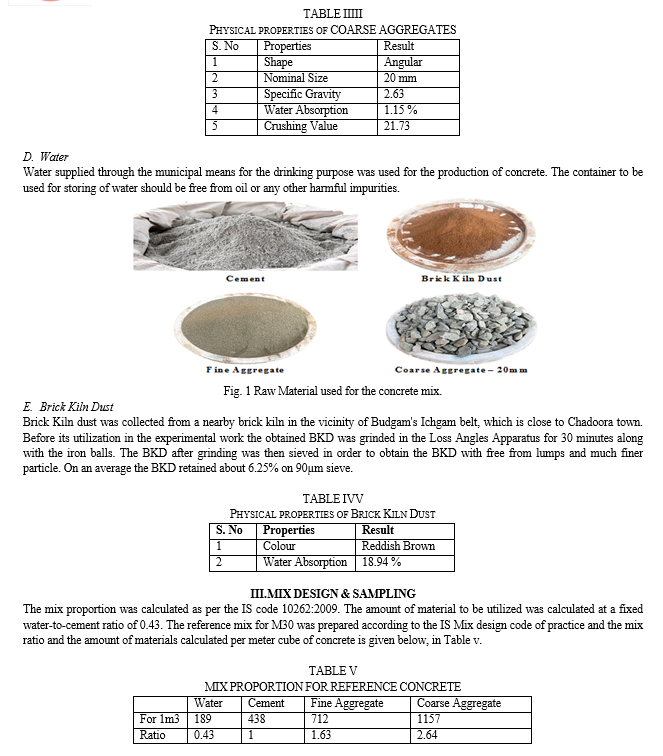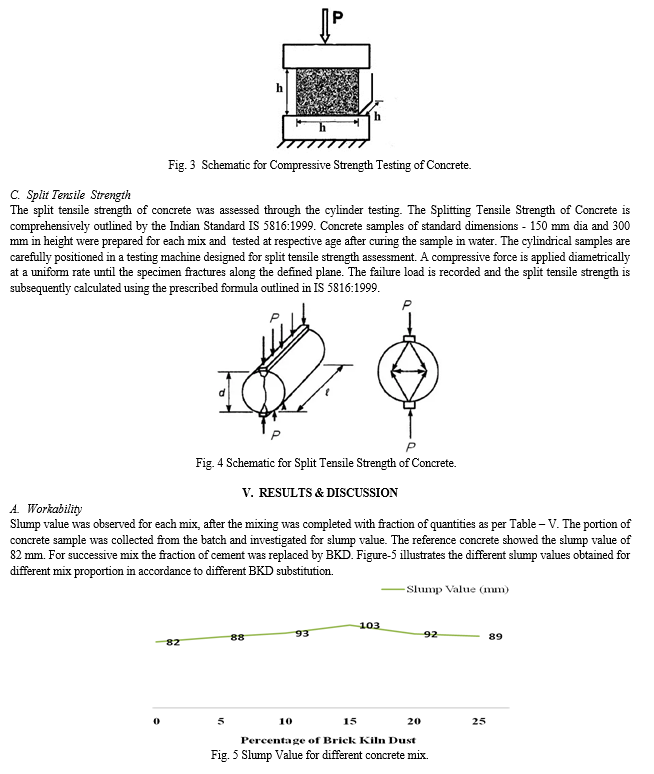Ijraset Journal For Research in Applied Science and Engineering Technology
- Home / Ijraset
- On This Page
- Abstract
- Introduction
- Conclusion
- References
- Copyright
Revolutionizing Construction - Harnessing the Power of Brick Kiln Dust as a Sustainable Cement Alternative
Authors: Suehail Aijaz Shah, Dr. Umer Mushtaq
DOI Link: https://doi.org/10.22214/ijraset.2024.58128
Certificate: View Certificate
Abstract
The concrete industry stands as the preeminent colossus within the realm of industrial domains. The building and construction industry, a primary contributor to environmental issues, is constantly seeking innovative approaches to enhance sustainability. Bricks forming the building block of the building structures are being manufactured worldwide. A substantial volume of fine particle dust is produced during the production step in the form of leftovers. This dust is the by-product of firing clay bricks at high temperature and the residual ash of the induced fuel. Brick Kiln dust poses environmental challenge due to disposal complexities. Commonly, the only established method of disposal is through land-filling, which can contribute to environmental concerns. This experimental investigation explores the transformative potential of utilizing Brick Kiln Dust as sustainable alternative to convention cement. BKD, obtained from a kiln situated in District Budgam, Jammu and Kashmir, was incorporated into concrete mixes at varying proportions (5%, 10%, 15%, 20%, and 25%) as a replacement for cement. Through the use of rigorous testing on mix samples, this study examined the effect of BKD on concrete workability as well as compressive and split tensile strength. The results were compared to identify the optimal dosage for achieving a balance between reduced cement consumption and maintaining structural integrity. The results showed that adding BKD not only significantly decreased the amount of cement used, but also demonstrated that it was a workable and sustainable substitute. This research not only addresses the environmental concern associated with BKD but also contributes to the ongoing efforts to develop sustainable construction practices.
Introduction
I. INTRODUCTION
The construction sector is a massive pillar that shapes the modern era's skylines and landscapes. The building industry creates a story of advancement and creativity with each brick laid, each carefully positioned beam, and every structure that rises from the earth, weaves a narrative of progress and innovation. Concrete, cement, aggregates, and bricks are among several materials utilized in the construction industry, these resources serve as the sector's backbone. In addition to consuming a variety of natural resources, the manufacture of these products leaves behind a number of environmental leftovers, some of which are hazardous to the environment. Bricks and concrete are among the fundamental building materials mostly used for the construction purpose, forming the large fraction of the construction material used in construction project. Production of Brick is a meticulous prcess that transforms raw material into a crucial building material, typically crafted from clay. The clay undergoes crushing and screening to achieve the desirable consistency following moulding and shaping the clay into brick through drying – air drying or passing them through the controlled air chamber, to reduced moisture content. The crucial firing stage takes place in the kilns, subjected to high temperature that vitrify the clay particle and impart strength. Cooling follows to prevent thermal shock. Brick Kiln dust byproduct of the process of making bricks in kilns, is usually made up of minerals found in the raw materials used to make bricks, as well as fine particles and residues left over after burning coal or other fuels. When bricks are being manufactured, the dust from the brick kiln is considered as a waste product. The main ingredients of the clay used for the production of bricks are silica (50–60%), alumina (20–30%), and various carbonates and oxides. Brick's pozzolanic characteristic is caused by clay. Although clay by itself lacks pozzolanic qualities, it acquires them throughout the brick-making process when it is burnt alongside lime[2]. District budgam is centrally located district of Kashmir valley. The lush green paddy fields of Budgam district are kashmir’s exhilarating landscape. Out of 282 brick kilns operating in the Kashmir valley, 232 are situated in Budgam district [1], functioning over 4,447 kanals of agricultural land. During the manufacturing process huge chunk of Brick kiln Dust is generated. This material is disposed of and used in landfills, which poses a risk to the environment and possibly human health.
The mineral composition of BKD can vary depending upon the characteristics of brick kiln dust can vary depending on factors such as the type of kiln, raw materials used and combustion process.BKD typically contains various compounds, including silica, alumina, iron oxide, and traces of heavy metals. When the BKD is not properly managed, it comes in contact with the top soil, thus contaminating it. This contamination may affect the soil fertility and impact the agricultural growth of the associated crop. Even the fine particles in the BKD can become airborne if not adequately controlled. Inhalation of these particles may pose respiration heath risk to workers and nearby resident, contributing towards the air pollution. Leaching of BKD may affect the water quality of the water table or nearby water bodies, even due to the runoff from the storage piles or improperly disposed BKD. Thus all these factors may ecologically contribute altogether impacting and disrupting the local ecosystems. Cement concrete is another used material used in large quantityOne of the most expensive ingredients in cement concrete is cement. Therefore, many researchers have explored the economical use of such substances to tackle environmental and financial issues by utilizing a variety of waste and innovative components in the concrete mix. The IS Method was used to prepare the concrete mix design for this experiential investigation. Further this study examined the properties of concrete by partially replacing the cement fraction by Brick Kiln Dust. Various properties of the modified concrete were evaluated and compared. The results revealed the possibility of utilization of BKD in the concrete mix, with improved performance. Therefore, utilization of BKD as partial substitution of cement will be a good alternate for BKD disposal problem, environmental concerns for the safe disposal of BKD, cement consumption in concrete production and also to the economical aspect of project cost as well.
II. MATERIAL
A. Cement
Cement in the form of fine powder is used as the binder for the cement concrete. Cement when mixed with other materials and water sets and hardens and binds other materials together. Locally available OPC 43 Grade ordinary Portland cement was used for this experimental setup. The cement procured was from the fresh batch and was physically test before its utilization in this investigation.





As illustrated with the addition of BKD there is variation in the split Tensile Strength with respect to reference concrete. The maximum gain of 14% was observed in the mix 15BKDC containing 15% of Brick Kiln Dust. However when the BKD content was further enhanced the trended reversed showing a decrease in Split Tensile Strength was noted. The enhancement in split tensile strength may be attributed to micro structural changes of the modified concrete. The pozzolanic reaction introduced by the addition of BKD by reacting with calcium hydroxide produced during cement hydration to form additional cementitious compounds results in the formation of denser hydration products and a more refined pore structure, which positively influences split tensile strength. Also the fine particles in Brick Kiln Dust can fill the voids in the concrete matrix, resulting in a denser and more compact structure. This filling effect also improve the resistance to cracking under tensile stresses. However when the BKD content is further increased from the optimum value, the split tensile strength starts to fall. This reduction in the split tensile strength with the higher BKD content may be attributed to incomplete hydration of cement particles arising due to the water entanglement due to the fine particle sizes and large surface area of BKD, causing increase the water demand of the concrete mix. Also the higher amounts of BKD may lead to incomplete hydration of cement particles. This can result in a less compact and weaker structure, affecting the tensile strength. All these factors may result in poor bonding between the cement matrix and BKD particles, creating weak interfaces that contribute to reduced tensile strength.
VI. SCOPE OF FUTURE WORK
To assess the viability of Brick Kiln Dust (BKD) in concrete, thorough research and experiments are essential. Focus on evaluating durability properties such as compressive strength, flexural strength, permeability, and resistance to environmental factors. Explore different BKD proportions, curing conditions, and durations to identify optimal blends. Collaborate across academia, industry, and regulatory bodies to establish standardized guidelines. Conduct a life cycle analysis for environmental impact. The goal is to unlock BKD's potential for creating cost-effective, durable, and sustainable concrete structures. Furthermore, the following recommendations are offered:
- Cost Savings: Cost savings through the utilization of Brick Kiln Dust in concrete can be recommended through Raw Material Substitution and Local Sourcing reducing the transportation costs.
- Business Opportunities: The utilization of Brick Kiln Dust in concrete opens up various business opportunities, fostering economic growth and job creation within the construction industry.
- Energy Efficiency: The utilization of Brick Kiln Dust in concrete can contribute to enhanced energy efficiency in several ways viz - Energy Recovery from BKD Production, Reduced Clinker Production by Optimized Concrete Mix Design along with Sustainable Construction Practices.
- Green Building Certifications: The utilization of Brick Kiln Dust in the construction industry can contribute positively to achieving various green building certifications. BKD into construction practices not only aligns with these green building certifications but also supports broader sustainability goals.
- Resource Conservation: The utilization of Brick Kiln Dust in the construction industry contributes to resource conservation by waste utilization reducing the demand for natural resources.
- Preservation of Ecosystem: Utilization of BKD is concrete, prevents the disposal of this byproduct in landfills. Thus the environmental impact associated with landfill usage and addressing waste management challenges, thus there is a reduction in the environmental impact associated with BKD disposal.
VII. ACKNOWLEDGMENT
We would like to express our gratitude to the Department of Civil Engineering, Government Polytechnic College Budgam, for their pivotal role in conducting the experimental investigation. We also appreciate the support from the Government Polytechnic College Budgam, which provided the necessary resources for this research. This acknowledgment reflects the collaborative efforts that contributed to the success of our project.
Conclusion
Brick dust was mixed into concrete in this experimental research project by partially substituting cement. In light of experimental research, the following conclusions can be made: 1) An alternative to cement in a concrete mix is brick kiln dust. 2) When compared to the controlled mix, the compressive strength increases with the addition of brick kiln dust. 3) The concrete mix became less workable when brick kiln dust was added. 4) The optimum quantity of brick kiln dust is 15% of the cement\'s weight, and this produces more favourable results than the control mixture. 5) The compressive strength at 28 days of age at optimum dosage showed 9% gain with respect to neat concrete. Once brick kiln dust content reaches 15%, compressive strength tends to rise; however, after this point, it tends to decline. 6) The split tensile strength with 15% of brick kiln dust substitution to cement had a marginal gain of 15% to the reference concrete\'s split tensile strength. 7) The integration of Brick Kiln Dust into concrete not only enhances the structural integrity of the material but also elegantly addresses the imperative for sustainable waste management. 8) Brick Kiln Dust as a cement substitute not only signifies a shift towards environmental sustainability but also unveils financial prudence, gracefully reducing project costs with economic wisdom.
References
[1] Source : State Pollution Control Committee and District Commissioner Office Budgam [2] Rogers, S. (2011). Evaluation and testing of brick dust as a pozzolanic additive to lime mortars for architectural conservation. https://www.semanticscholar.org/paper/Evaluation-and-Testing-of-Brick-Dust-as-a-Additive-Rogers/181369bed0d59f29f201e0353324f26782d6fe55 [3] Kazmi, S. M. S., Abbas, S., & Khitab, A. (2016). Exploratory study on the effect of waste rice husk and sugarcane bagasse ashes in burnt clay bricks. Journal of Building Engineering, 7, 372–378. https://doi.org/10.1016/j.jobe.2016.08.001 [4] De Silva, G. S., & Surangi, M. (2017). Effect of waste rice husk ash on structural, thermal and run-off properties of clay roof tiles. Construction and Building Materials, 154, 251–257. https://doi.org/10.1016/j.conbuildmat.2017.07.169 [5] Suehail, M.A. , (2024). Enhancing Concrete Setting Time with Sustainable Innovation - Utilizing Apple Juice as a Retarder Agent, International Research Journal of Engineering and Technology, 56-62 , https://www.irjet.net/archives/V11/i1/IRJET-V11I110.pdf [6] Rogers, S. (2011). Evaluation and testing of brick dust as a pozzolanic additive to lime mortars for architectural conservation. https://www.semanticscholar.org/paper/Evaluation-and-Testing-of-Brick-Dust-as-a-Additive-Rogers/181369bed0d59f29f201e0353324f26782d6fe55 [7] Elshaboury, N., Al-Sakkaf, A., Abdelkader, E. M., & Alfalah, G. (2022). Construction and Demolition Waste Management Research: A Science Mapping analysis. International Journal of Environmental Research and Public Health, 19(8), 4496. https://doi.org/10.3390/ijerph19084496 [8] Ullah, M. S., Ullah, S., Javed, M. F., Ullah, R., Akbar, T. A., Ullah, W., Baig, S. A., Aziz, M., Mohamed, A., & Sajjad, R. U. (2022). Assessment and Impacts of Air Pollution from Brick Kilns on Public Health in Northern Pakistan. Atmosphere, 13(8), 1231. https://doi.org/10.3390/atmos13081231 [9] Sikder, A. H. F., Begum, K., Parveen, Z., & Hossain, M. F. (2016). Assessment of macro and micro nutrients around brick kilns agricultural environment. Information Processing in Agriculture, 3(1), 61–68. https://doi.org/10.1016/j.inpa.2016.02.001 [10] Swati, S., Thakur, I. S., Vijay, V. K., & Ghosh, P. (2018). Scenario of landfilling in India: problems, challenges, and recommendations. In Springer eBooks (pp. 1–16). https://doi.org/10.1007/978-3-319-58538-3_167-1 . [11] IS:2386 (PartI,III)-1963: Methods of Test for Aggregates for Concrete Bureau of Indian Standard, New Delhi-1963. [12] IS383-1970 Specification Of Fine And Coarse Aggregates. [13] IS 10262-1981 IS Method Of Mix Design. [14] IS:5816-1999: Methods of test for Splitting Tensile Strength of Concrete, Bureau of Indian Standard, New Delhi-1999.
Copyright
Copyright © 2024 Suehail Aijaz Shah, Dr. Umer Mushtaq. This is an open access article distributed under the Creative Commons Attribution License, which permits unrestricted use, distribution, and reproduction in any medium, provided the original work is properly cited.

Download Paper
Paper Id : IJRASET58128
Publish Date : 2024-01-21
ISSN : 2321-9653
Publisher Name : IJRASET
DOI Link : Click Here
 Submit Paper Online
Submit Paper Online

